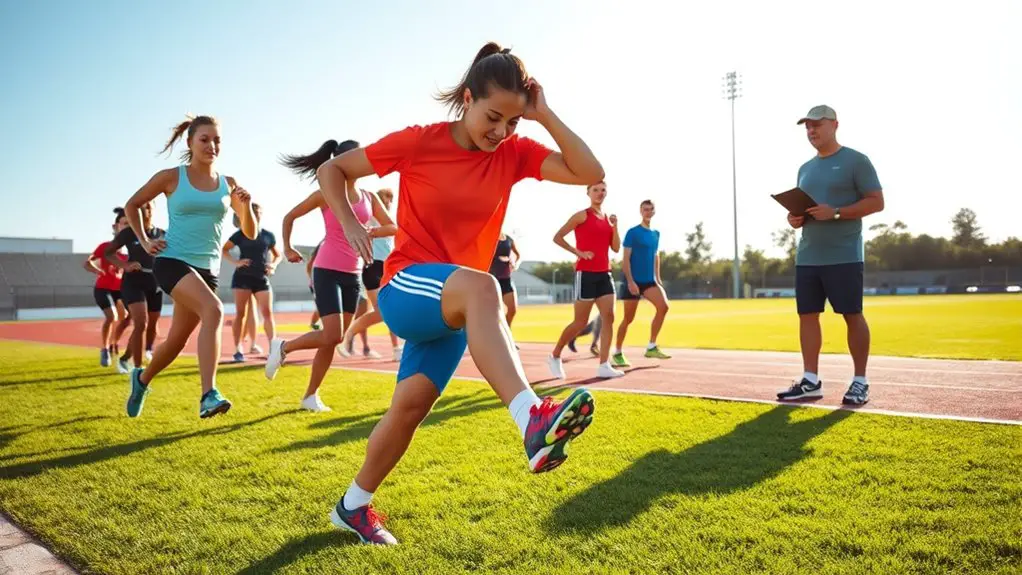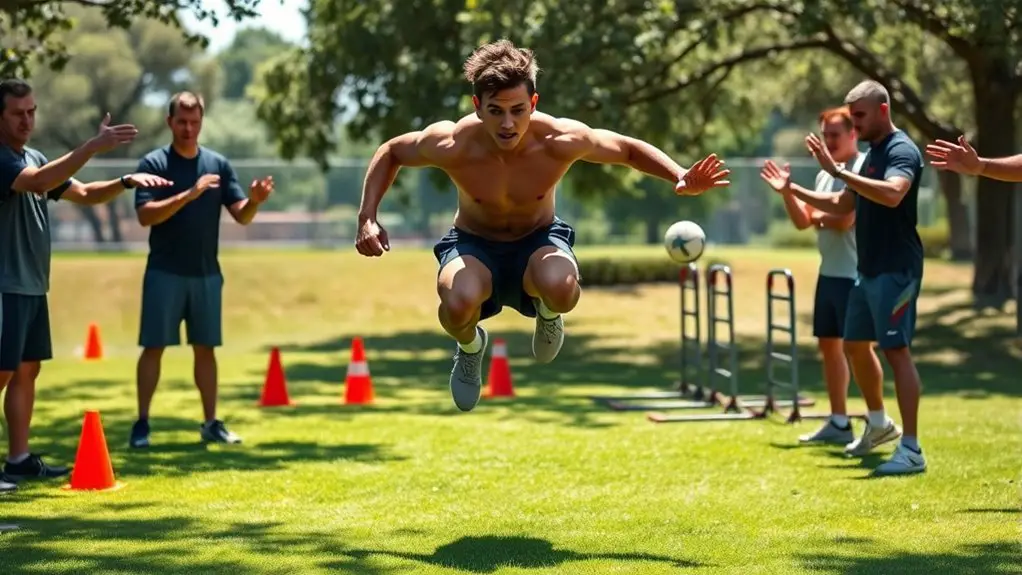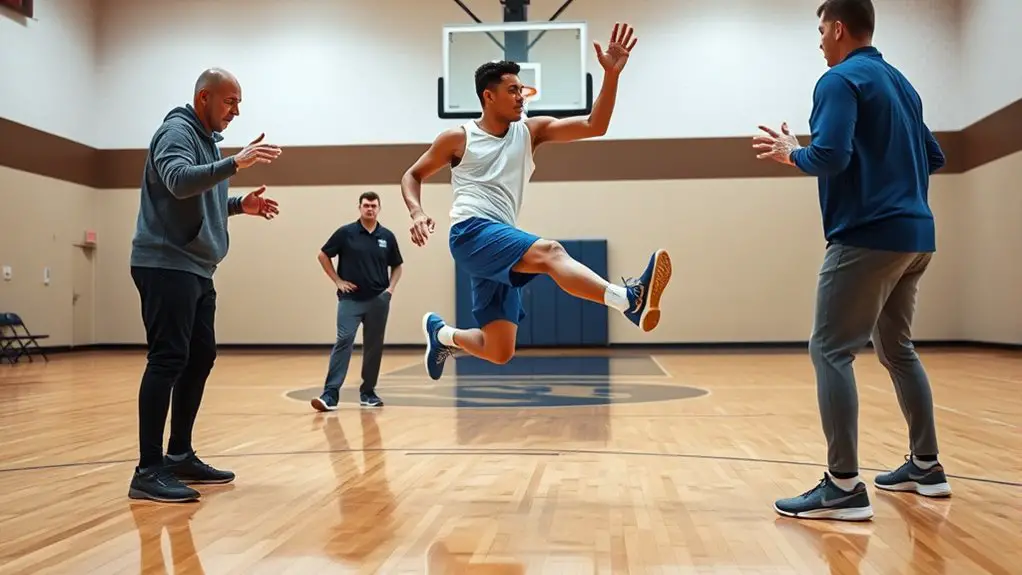To prevent recurring sports injuries, you need to focus on a combination of proper warm-up and cool-down routines, strength and conditioning exercises, and flexibility training. Always listen to your body and recognize signs of overuse, like persistent soreness or fatigue. Incorporating professional guidance can help you design a tailored training plan and rehabilitation program. Pay attention to your needs, and you'll maintain peak performance. There's more to discover that can enhance your injury prevention strategies.
Understanding the Common Causes of Sports Injuries
When you immerse yourself into the world of sports, it's crucial to understand the common causes of injuries to stay safe and perform your best. One major factor is overexertion; pushing your body beyond its limits can lead to strains and sprains. You might also encounter injuries from improper technique. Whether you're running, jumping, or throwing, using the wrong form can seriously increase your risk.
Additionally, playing on uneven surfaces can result in falls or twisted ankles, so always be aware of your environment. Fatigue is another culprit; when you're tired, your focus wanes, and your reaction time slows, making injuries more likely. Finally, inadequate gear can leave you vulnerable. Confirm your equipment fits well and offers the right support. By recognizing these common causes, you can take proactive steps to minimize risks and enjoy the freedom that sports bring without the worry of injury. Furthermore, incorporating proper warm-ups is essential for preparing your body and reducing the likelihood of injury.
The Importance of Proper Warm-Up and Cool-Down Routines
When you warm up before exercise, you're preparing your body for the demands ahead, reducing the risk of injury. A proper cool-down helps your body shift back to a resting state, promoting recovery and flexibility. Understanding these routines is key to staying safe and performing your best. Additionally, incorporating dynamic stretching into your warm-up routine can significantly enhance your muscle activation and overall performance.
Benefits of Warm-Up
Although it might seem like a hassle, incorporating a proper warm-up and cool-down routine into your sports practice is essential for injury prevention and overall performance. A good warm-up prepares your body, increasing blood flow and flexibility while reducing muscle stiffness. You'll feel energized and ready to tackle your activity with less risk of injury.
| Benefit | Description | Impact on Performance |
|---|---|---|
| Increased Blood Flow | Warms up your muscles | Enhances endurance |
| Improved Flexibility | Increases joint range of motion | Boosts agility |
| Mental Preparation | Focuses your mind on the game | Enhances concentration |
| Injury Prevention | Reduces risk of strains and sprains | Promotes longevity in sports |
Embrace warm-ups to release your full potential!
Effective Cool-Down Techniques
How can you guarantee your body recovers effectively after intense activity? A proper cool-down is essential. After pushing your limits, take time to let your heart rate gradually decrease. Start with light jogging or walking for about five to ten minutes. This helps flush out lactic acid and prevent stiffness.
Next, incorporate static stretching. Focus on major muscle groups you've worked; hold each stretch for 15-30 seconds. This promotes flexibility and reduces muscle tension, making you feel freer and more agile.
Don't forget to hydrate! Replenishing fluids is key to recovery. Listen to your body—if something feels off, give it the rest it deserves. With these techniques, you'll keep your body in top shape and ready for your next adventure.
Injury Prevention Strategies
To effectively prevent injuries, it is crucial to prioritize both warm-up and cool-down routines. These practices prepare your body for activity and aid recovery, keeping you active and free. A proper warm-up increases blood flow and flexibility, while a cool-down helps reduce muscle soreness.
| Warm-Up Activities | Cool-Down Activities |
|---|---|
| Dynamic stretches | Static stretches |
| Light jogging | Walking |
| Mobility drills | Foam rolling |
| Sport-specific drills | Deep breathing |
| Activation exercises | Gentle yoga |
Incorporating these routines into your sports regimen helps you avoid injuries and maintain your freedom to play. So, take the time to warm up and cool down, and your body will thank you!
Strengthening and Conditioning for Injury Prevention
To keep injuries at bay, focusing on core stability, balance, and flexibility is essential. These elements not only enhance your overall performance but also support your body's ability to withstand physical stress. By incorporating targeted exercises into your routine, you'll build a strong foundation for safer sports participation. Additionally, prioritizing core strength development can significantly reduce the risk of injuries by stabilizing the spine and pelvis during physical activities.
Importance of Core Stability
Core stability plays an essential role in injury prevention, acting as the foundation for nearly every movement in sports. When you strengthen your core, you're enhancing your body's ability to stabilize itself during dynamic activities. A strong core allows for better posture, balance, and overall movement efficiency, reducing the risk of injuries. Whether you're sprinting, jumping, or shifting direction, your core muscles work to support your spine and pelvis, keeping you agile and in control. Don't underestimate the impact of core stability on your performance; it's key to releasing your full athletic potential. Incorporating core exercises into your routine can be a game-changer, giving you the freedom to move confidently and enjoy your sport without the nagging worry of injury.
Balance and Flexibility Training
While many athletes focus on strength training, incorporating balance and flexibility exercises is equally essential for preventing injuries. You might think that building muscle is enough, but without proper balance, your body can't support itself effectively during dynamic movements. Flexibility helps maintain your range of motion, reducing the risk of strains and sprains.
Try integrating yoga or Pilates into your routine to enhance flexibility and core strength. Balance training, like single-leg exercises or stability ball workouts, can improve your coordination and proprioception. These practices not only keep you injury-free but also boost your overall athletic performance. Embrace this holistic approach, and you'll feel more agile and resilient on the field or court, giving you the freedom to play your best without limitations.
The Role of Flexibility and Mobility Training
Flexibility and mobility training play an essential role in preventing sports injuries. By incorporating these practices into your routine, you can enhance your range of motion, improve performance, and reduce the risk of injury. Here's why you should prioritize flexibility and mobility:
- Increases Range of Motion: Greater flexibility allows your joints and muscles to move more freely.
- Improves Performance: Enhanced mobility can lead to better movement efficiency in your sport.
- Reduces Muscle Tension: Stretching helps relieve tightness, promoting relaxation and ease of movement.
- Enhances Recovery: Mobility exercises can aid in muscle recovery after intense workouts or competitions.
- Promotes Balance: A well-rounded flexibility regimen supports overall body balance, reducing the chance of falls or strains.
- Empowers Exploration of various mobility techniques to improve your movement freedom and adaptability during sports activities.
Incorporate dynamic stretches and mobility drills into your warm-ups or cool-downs, and enjoy the freedom of movement they provide. Your body will thank you!
Listening to Your Body: Recognizing Signs of Overuse
Listening to your body is essential for preventing sports injuries, especially when it comes to recognizing signs of overuse. Ignoring these signals can lead to more severe injuries that could sideline you for longer than you'd like. Here are some signs to watch for:
| Sign | What to Do | Importance |
|---|---|---|
| Persistent soreness | Rest and ice | Prevents escalation of injury |
| Decreased performance | Reassess training intensity | Maintains overall progress |
| Swelling or stiffness | Consult a professional | Guarantees proper diagnosis |
| Fatigue during workouts | Incorporate recovery days | Enhances long-term performance |
Recognizing these signs isn't just about avoiding injury; it's about listening to what your body needs. By tuning in, you can maintain your freedom to play and enjoy the sports you love without the worry of recurring injuries. Additionally, ensuring you have proper warm-up techniques can significantly reduce the risk of hamstring injuries and other overuse problems.
Utilizing Professional Guidance and Rehabilitation Services
When you're serious about preventing sports injuries, seeking professional guidance can make all the difference. Whether you're a weekend warrior or a seasoned athlete, tapping into expert advice gives you the freedom to perform at your best without the fear of setbacks. Here's how professionals can help:
- Customized Training Plans: Tailored workouts that suit your specific needs.
- Injury Assessment: Identifying weaknesses before they lead to injuries.
- Rehabilitation Programs: Structured recovery paths to get you back on track.
- Nutritional Guidance: Fueling your body for peak performance, including the importance of electrolyte balance in muscle function.
- Ongoing Support: Continuous motivation and adjustments to your regimen.
Frequently Asked Questions
How Does Nutrition Impact Injury Recovery and Prevention?
Nutrition plays an essential role in your injury recovery and prevention. It fuels your body, aids healing, and strengthens tissues. Prioritizing a balanced diet can enhance your resilience, helping you bounce back faster and stay active.
Can Mental Health Influence the Likelihood of Sports Injuries?
Isn't it curious how your mind shapes your body? Mental health can indeed influence injury likelihood. Stress and anxiety can lead to poor focus and reaction times, increasing your risk of accidents during sports activities.
What Are Common Myths About Sports Injury Prevention?
You might believe that simply stretching before a game prevents injuries, or that more pain equals more gain. Remember, proper recovery and listening to your body are vital; myths can lead to unnecessary setbacks.
How Often Should I Change My Athletic Footwear?
You should change your athletic footwear every 300 to 500 miles, depending on wear. Ignoring this might lead to discomfort or injury, so staying aware of your shoes' condition keeps you free to perform at your best.
Are There Specific Injuries More Likely in Certain Sports?
Yes, certain sports do have common injuries. For instance, runners often face knee issues, while basketball players might deal with ankle sprains. Knowing these risks helps you stay aware and proactive in your training.




